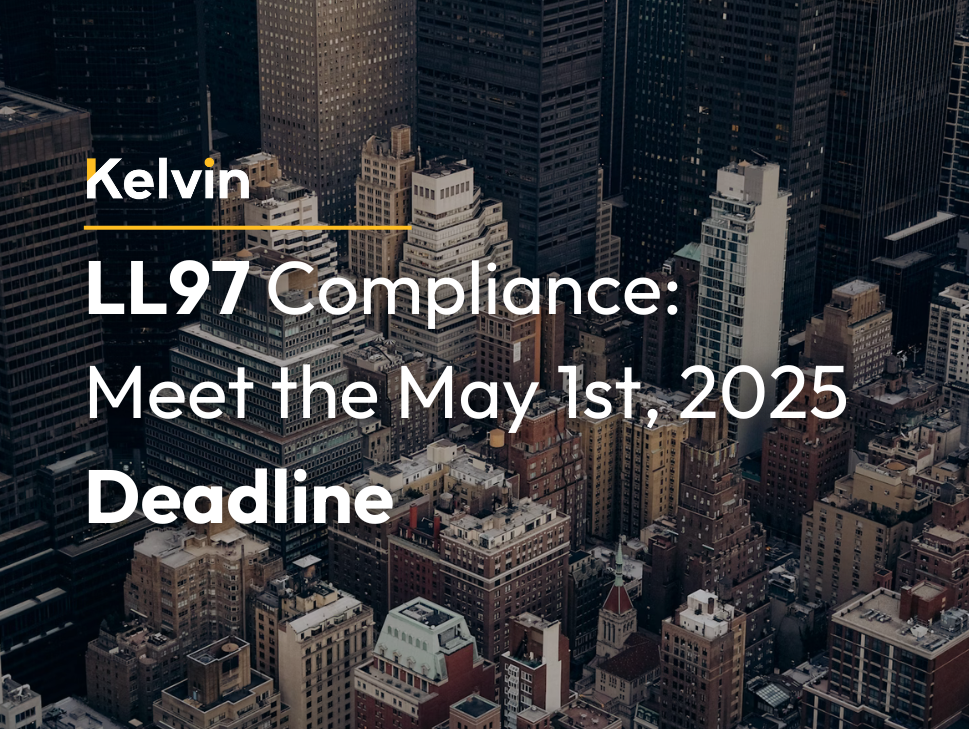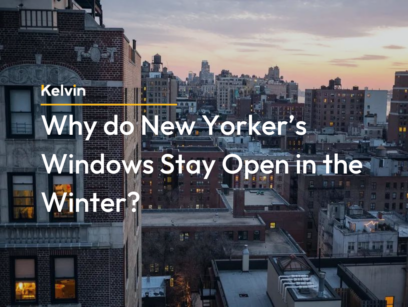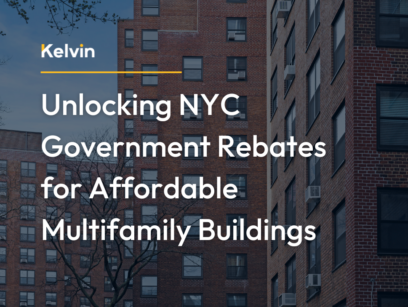
New York City passed Local Law 97 (LL97) in 2019, part of the Climate Mobilization Act, establishing carbon limits for some of the city’s largest buildings. Buildings covered by LL97 must cut emissions by 40% by 2030, with a net zero goal by 2050. To meet this goal, there are key deadlines to look out for, and the first one is on May 1st, 2025, requiring building owners to submit their first annual emissions compliance report.
Check out this guide to learn how to submit your report and measures you can take to avoid penalties!
(Note: Buildings subject to Article 321 (certain types of affordable housing and houses of worship) may qualify for delayed deadlines or reduced requirements. If you’re unsure whether you qualify, confirm your building’s status using the NYC Department of Buildings (DOB) online portal.)
1. Check If Your Building Must Comply
Local Law 97 applies to:
- Single buildings larger than 25,000 square feet.
- Groups of buildings on the same tax lot totaling more than 50,000 square feet.
- Multiple buildings owned by a condo association and governed by the same board whose combined size exceeds 50,000 square feet
2. Mark These Critical Dates
- May 1, 2025: Submit your first annual emissions report for 2024.
- June 30, 2025: If, for whatever reason, you miss the May 1 deadline, this is the grace period to file without penalties. After this, the city will charge $0.50 per square foot each month (ex: $12,500/month for a 25,000-square-foot building).
- August 29, 2025: Last day to request an extension if you hire a licensed professional to help with compliance.
Penalties:
- Exceeding emissions limits costs $268 per metric ton of carbon.
- For Article 320 buildings, failure to file a building emissions report by the deadline will result in a fine of $0.50 per square foot for each month the report is not filed.
- False statements will be subject to a fine of $500,000.
3. File Your Report
The submission process requires three different accounts. You will need a DOB NOW account if you don’t have one already, an EPA Energy Star Portfolio Manager account (ESPM), and a Building Energy Analysis Manager (BEAM) account. All three of these accounts should be used using the same credentials so that they can be linked to each other. Once you have filed the necessary paperwork through the various accounts, the DOB staff will communicate any issues and results through your BEAM account.
Here is a breakdown of the process:
STEP 1: Create a DOB NOW account
If you don’t have an account yet, create one now. You will pay your filing fee through DOB NOW.
STEP 2: Create an ESPM account.
This profile is used to log building details. Make sure you link the profile to the building’s utility providers so that the utilities can automatically upload energy consumption data to your profile.
STEP 3: Create a BEAM account.
Use the same credentials as you did for DOB NOW and ESPM. This way the accounts will be linked, simplifying your filing process.
STEP 4: Upload supporting documents to BEAM.
This involves any templates and supporting documents regarding Article 321, as well as any other LL97 compliance report submissions.
STEP 5: Review BEAM assessment.
BEAM will assess whether your building is within its calculated emissions limit. Once you have reviewed its assessment, you must upload a signed attestation that the information is accurate to the best of your knowledge.
STEP 6: Await results.
Once you have officially submitted your documents, a DOB staff member will review your application. Any issues and results will be communicated through your BEAM account.
There are three possible outcomes:
- Compliant building
- Non-compliant building, pay penalty
- Non-compliant building, mediated resolution
In the case of the third outcome, you will be required to submit a secondary report that demonstrates Good Faith Efforts (GFE) towards compliance. More information about GFE reporting requirements can be found here: Article 320 Info Guide.
4. Your Compliance Plan
If you find that you need to lower your building’s emissions, there are a couple steps you can take.
Invest in Energy Efficiency Measures:
Nearly 70% of New York City’s carbon emissions come from fossil fuels used to heat, cool, and power buildings. Targeting your building’s heating system is an effective way to meet your building’s emissions cap.
Installing an internet connected, smart radiator cover, like the Cozy, can reduce energy use by 25-45%, helping you avoid potential fines. Additionally, because the Cozy is an electric heating system used to displace fossil fuel sources and less efficient heating systems, you can use a beneficial electrification emissions coefficient when calculating your building’s emissions. You can subsequently apply the emissions saving in that reporting year, or accrue it for future reporting years.
How the Cozy Works:
- Prevents overheating: It works by trapping heat inside the insulated cover, and using a thermostatically controlled fan, it either releases heat when it senses temperatures falling or keeps heat trapped when it senses that the room has reached a comfortable temperature.
- Balances Temperatures: Sensors adjust heat output room-by-room, eliminating cold spots and reducing boiler strain.
- Tracks Data: Property managers get real-time insights into energy use, helping optimize heating schedules and identify savings.
Additionally, to incentivize electrification efforts, there are resources that can help save money on these projects.
- Utility Rebates: Con Edison and National Grid provide energy efficiency rebates for the Cozy.
- Tax Credits: The Inflation Reduction Act (IRA) covers 30% of costs for upgrades like The Cozy, lowering the price to about $30 per unit.
- NYSERDA Grants: Get free energy audits or funding for efficiency projects.
- Low-Interest Loans: Programs like PACE financing help spread upgrade costs over time.
Other efficiency measures you can take are improving building insulation and switching to LED lightbulbs.
True Up:
After taking those measures, try truing up with Renewable Energy Credits (RECs). As you look to purchase RECs, keep in mind that you cannot meet LL97 requirements solely through RECS and all RECs must be associated with renewable energy resources located in or whose output directly sinks into New York City.
Submit a Green Upgrade Plan
If you need more time, share a plan to electrify your building or replace fossil fuel systems. This can delay penalties for up to two years.
5. After You Submit
The DOB will review your report and may ask for corrections. Respond within 60 days to keep your filing on track.
Your Compliance Checklist
☑ Confirm if LL97 applies to your building.
☑ Enter your building information into DOB NOW, ESPM, and BEAM.
☑ Come up with a compliance plan
☑ Certify and submit your report by May 1 (or June 30 at the latest).
Final Note
Local Law 97 pushes NYC towards a more sustainable future and saves money for buildings that act now.
Need support? Learn how Kelvin’s Cozy radiator covers can help your building meet LL97. This guide references NYC DOB guidelines. For official rules, visit the DOB’s LL97 website.

